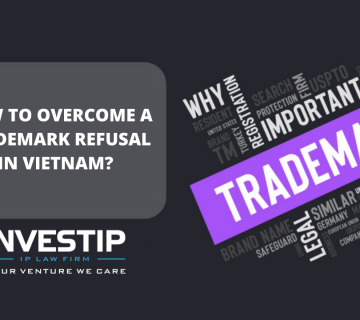Overview:
After filing, a patent application must be formality examined in order to obtain the notification of officially acceptance. In this examination, the examiner and the applicant will give-and-take opinions via formality Office Action(s). A formality Office Action (OA) will include the reasons why invention(s) claimed in the application(s) have been refused to accept as formal or what requirements in formality must be satisfied.
Details of formality Office Action
Under the terms of Vietnam IP law, a formality OA will be issued within 01 month from filing date, if a patent application has the deficiencies in the formality stage (Rule 13.8.a of Circular 01/2007/TT-BKHCN). The time limit for the applicant providing with a written response to the formality OA is 01 month from the signing date of the OA (Rule 13.3 of Circular 01/2007/TT-BKHCN). And if the applicant needs more time to consider the case, he is entitled to request for an extension of time for 01 month by a written request once only. However, in practice, a request for the second extension of time can be acceptable if it has been approved by Vice Director of the NOIP. Failure to timely respond or the response does not satisfy the requirements given in the OA, the NOIP may issue a decision on refusal on official acceptance for the application.
The formality examination comply with the procedure in Rule 13.1 of Circular No. 01/2007/TT-BKHCN such as in order to reach a conclusion on whether the application can be considered as proper application or not.
In range of formality examination, a patent application will be carried out via the follow steps: examining the formality of all documents in the application and preliminary examining the content of all documents in the application. Thus, there are so many forms of formality OA that may be issued, e.g., about the required documents at filing, the right to file the application, the priority right, the formality of specification, and the formality of claims, etc.
In this article, we only focus on the main contents of formality Office Action that have usually been addressed in the formality stage such as the documents required at filing, the structure of specification, the formality of claims.
1. The documents required at filing:
At the time of filing a patent application, the filing documents as required are as follows: the filing request, the specification, the abstract, Power of Attorney (POA), the documents for certifying the right to file the application or proving the priority right (if any) and the official receipt of filing fees (Rules 7.1, 7.2.b, 13.2 and 13.3 of Circular 01/2007-TT-BKHCN). It is noted that the filing documents must be prepared in Vietnamese (except for documents, certifying the right to file the application or proving the priority right, their Vietnamese translation may be required at examiner’s request).
If a patent application lacks one of the said documents or is prepared by language other than Vietnamese, examiners will ask the applicant to provide the NOIP with the missing documents or Vietnamese translation thereof.
In practice, there are some documents that can be submitted after filing, such as Power of Attorney (POA). In respect of an application filed in accordance with the Patent Co-operation Treaty (PCT application), a POA shall be submitted within 34 months from the first priority date. In other kinds of a patent application, a POA must be submitted within 01 month counted from the date on which the NOIP’s examiner issued an OA to notify the deficiencies and requiring the applicant to supplement with the same to the NOIP.
In addition, other deficiencies given in the formality OA are usually the mistakes or unclear information on the name/address of applicant(s), inventor(s) or the deficiencies in relation to the bibliographic data, etc. Such deficiencies will be overcome by explaining/correcting the information or adding the documents as required.
2. The structure of specification:
Under Vietnam IP Law and regulations, the specification of a patent application must comprise description part, set of claims, abstract, drawing (if any).
In light of the description part, it must contain the following items: Title of invention, Technical filed of invention, Background art (prior art) of invention, Summary of invention, Brief description of drawings (if any), Detail description of embodiments, Examples and Advantageous Effects of Invention (Rule 23.6 of Circular 01/2007-TT-BKHCN). If the description part lacks one of the said items, the NOIP’s examiners will issue the formality OA to ask the applicant adding the missing item appropriately.
In addition, the NOIP’s examiners often raise the objection about the title of invention. As stipulated in Vietnamese IP law, the title of invention must briefly describe the subject-matters claimed in the patent application. The title must be a succinct title and not an expanded or an advertisement title. In order to overcome the objection about the title, it should be revised to reflect the main subject-matters in the set of claims.
3. The formality of claims:
In order to determine whether the claimed subject-matters in a patent application are suitable to Vietnam IP Law and Regulations or not, examiners will examine the set of claims then issue the formality OA for the claims if they belong to the following cases:
- The claims relate to one of the following un-patentable subject-matters: (1) scientific discoveries or theories, mathematical methods; (2) schemes, plans, rules and methods for performing mental acts, training domestic animals, playing games and doing business, computer programs; (3) presentations of information; (4) solutions of aesthetic characteristics only; (5) plant or animal varieties; (6) processes of plant or animal production which are principally of a biological nature, other than microbiological processes; (7) methods for prevention, diagnostic and treatment disease in human and animal (Article 59 of IP Law 2005). Such un-patentable subject-matters should be re-formatted or removed appropriately.
In fact, the un-patentable subject-matters being disputed now are “use” and “method of treatment of a disease” claims. In order to resolve this problem, we can revise these claims into other formats, for example, “use” claims may be revised into “a compound for use”, “method of treatment disease” claims may be revised into “a compound for use in treating”. However, if revising into format “a compound for use” or “a compound for use in treating” is overlapped the existing claims, such un-patentable claims should be removed. Please note that such amendments are accepted in formality aspect only and the use claims may be rejected in substantive examination stage.
- The technical solution of the claimed subject-matters is contrary to government regulations (e.g., equipment for using narcotic, device for making the counterfeit money, etc.), contrary to social ethics and public order which harm the public utilities (e.g., method of copulation between human and animal, method of human reproductive cloning, etc.) or which harm national defence and security (Article 8.1 of IP Law 2005). Concerning the prohibited subject-matters, there is no way that could be made for overcome this objection. Removing fully/partially such prohibited subject-matters is the best way in this case.
The further objection on the claims is one claim containing more than one subject-matter (Rule 23.6.k of Circular 01/2007/TT-BKHCN). In order to overcome such objection, the rejected claim should be divided suitably so that one claim relates to only one subject-matter.
In addition, if the claims refer to the description and drawings, it will be rejected (except where a reference is made to sections which are not able to be described accurately in words, such as nucleotide and amino acid sequence listings, refraction charts and status flowcharts and so forth) (Rule 23.6.g of Circular 01/2007/TT-BKHCN). For overcoming this rejection, the claims referring to the description and drawings should be removed.
Finally, after all objections in the formality examination are overcome, a Decision on formality acceptance will be issued. From receiving the Decision on formality acceptance, the formality examination stage finishes. After that, a patent application will be published on the Industrial Property Gazette in the nineteenth month from the first priority date or from the filing date (if there is no priority date) (for a patent application as filed under Paris Convention) or within two months from the date on which the application is officially accepted (for PCT application), whichever is the later (Rule 14.2 of Circular 01/2007/TT-BKHCN). Then a patent application will be passed into the substantive examination stage if the substantive examination procedure is requested.
Sources
- National Office of Intellectual Property website:
- Vietnamese Intellectual Property Law 2005 (amended some Articles in 2009):
- Circular 01/2007/TT/BKHCN of Ministry of Science and Technology on February 14, 2007 for providing guidelines for implements the law on IP with respect to Industrial Property Rights (amended some Rules in 2010, 2011 and 2013):




